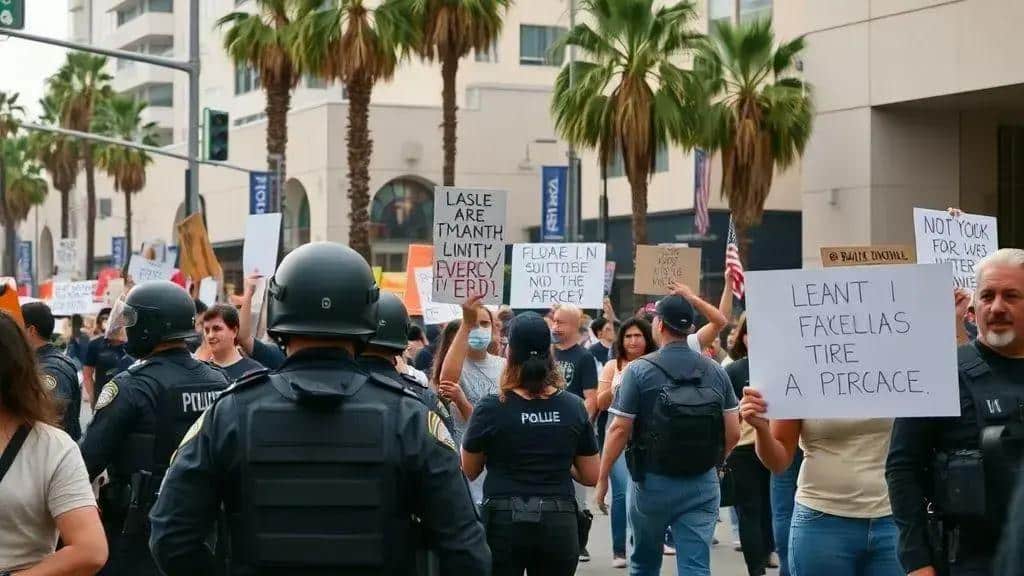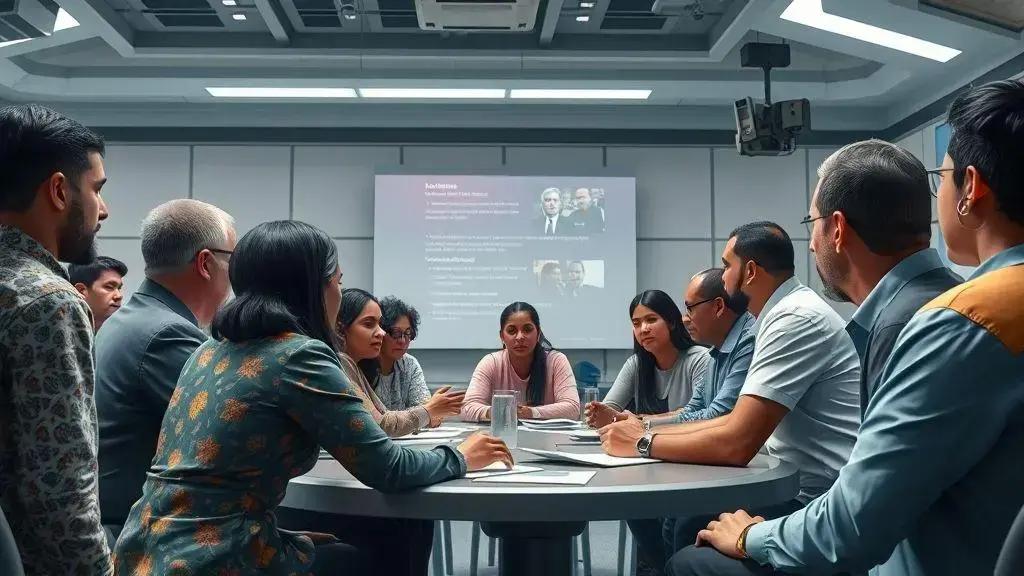LA protest cost $134M; over 4,000 guard troops deployed

The LA protests, costing the city approximately $134 million, led to the deployment of over 4,000 guard troops and prompted discussions around social justice and policy reforms for improved community relations.
LA protest cost $134M; it’s hard to wrap your head around such staggering figures. What does this mean for Los Angeles and its residents? Let’s dive into the details.
Overview of the LA protests
The recent protests in LA have caught significant attention, largely due to the cost involved and the overwhelming response by authorities. Understanding the events that led to these protests is essential to grasping the broader implications for the community.
Initially sparked by social and political issues, the protests quickly grew in scale and intensity. Thousands of participants took to the streets, voicing their demands for change. The multifaceted nature of these demonstrations makes it important to analyze not only the motivations behind them but also their impact.
Key Factors Behind the Protests
Several key factors contributed to the escalation of the LA protests:
- Social Justice: Many protesters call for greater equality and fair treatment of all community members.
- Police Accountability: A significant demand has emerged for more transparency and accountability from law enforcement.
- Economic Inequality: The disparity between different socioeconomic groups in LA has fueled frustration and calls for action.
As these vital issues gather momentum, it’s clear that the protests represent a culmination of ongoing tensions. People are not just expressing their feelings; they are demanding genuine change.
Community Response to the Demonstrations
The response from local authorities, including the deployment of over 4,000 guard troops, has had mixed reactions.
- Increased Security Measures: The visible presence of troops aims to maintain order but has also raised concerns about escalating tensions.
- Engaging with Protesters: Some officials have attempted to open dialogues with leaders of the protests, indicating a willingness to listen.
- Public Sentiment: Citizens hold varied views on police presence, with some supporting it for safety and others seeing it as an act of aggression.
While the protests continue, the dialogue surrounding them evolves. It’s important for everyone to stay informed about these developments, as they can have lasting implications for the city of Los Angeles.
Financial impact on the city

The financial impact on the city due to the LA protests is profound and multifaceted. With costs estimated at $134 million, the repercussions reach beyond immediate expenditures. City officials are now faced with the challenge of balancing budgets and maintaining essential services.
Expenses related to law enforcement, property damage, and emergency services have surged. The need for additional security has strained the city’s resources, prompting tough budgetary decisions. As these costs accumulate, the community feels the effects in various ways, particularly in essential services and infrastructure maintenance.
Breakdown of Financial Impacts
Several areas are significantly affected by the financial strain:
- Law Enforcement Costs: The deployment of thousands of guard troops has led to increased costs associated with security and resource allocation.
- Property Damage: Many businesses and public facilities have suffered damages, leading to repair costs that further strain local budgets.
- Emergency Services: Increased demand for emergency response has led to higher operational costs for local services.
As the city grapples with these unforeseen expenses, the financial ripple effects are becoming evident. Local government budgets may undergo significant revisions to accommodate these new financial realities, affecting programs and services that residents rely on daily.
Long-term Fiscal Considerations
These immediate financial impacts could lead to long-term implications for city planning. The ongoing financial burden from the protests may hinder future investments or improvements that the city desperately needs. Citizens are concerned about how the city will prioritize funding amidst ongoing fiscal challenges.
As discussions around the protests continue, the notion of accountability, not just for people but also for urban finance, must take center stage. Community members are calling for transparency in how the financial implications of protests are handled, demanding that funds are wisely utilized to foster recovery and growth.
Deployment of guard troops and local response
The deployment of guard troops in response to the LA protests has been a prominent topic of discussion. This call for additional security arose due to the scale and intensity of the demonstrations, leading officials to take decisive action. Understandably, deploying such a number of troops can alter the city’s landscape both physically and socially.
With over 4,000 troops mobilized, local authorities aimed to restore order and ensure the safety of citizens. However, this response was met with mixed feelings among residents. While some argue that the presence of troops helps maintain peace, others believe it escalates tensions within the community.
Community Reactions
The community’s reaction to the deployment varied widely, reflecting differing views on safety and authority:
- Support for Troops: Some community members feel safer with an increased security presence during protests.
- Concerns of Aggression: Others view the presence of troops as an act of aggression, fearing it may incite further unrest.
- Calls for Dialogue: Many advocate for more dialogue between city officials and protest leaders to reduce tensions and foster understanding.
The local government’s strategy aims not only to manage the protests but also to communicate effectively with the public. This involves listening to the community’s concerns and aiming for transparent dialogue. As the situation unfolds, the impact of these deployments will be critical in shaping public sentiment and trust in local governance.
Coordination Among Agencies
Another aspect of this deployment is the coordination between various agencies. Law enforcement, municipal services, and the National Guard have had to work closely to ensure a comprehensive approach. This collaboration is crucial in addressing safety concerns while also respecting the rights of protesters. Good communication between these groups can lead to more effective management of events and better outcomes for everyone involved.
As city leaders navigate these complex dynamics, the focus remains on finding a balance between maintaining public safety and respecting the democratic rights of individuals to protest peacefully. The ongoing discourse will be critical in defining how these events affect future policy and community relations.
Looking ahead: future implications for LA

Looking ahead, the future implications for LA following the recent protests and their financial repercussions are significant. The city’s landscape is bound to change as a result of ongoing discussions around social justice, public safety, and community engagement. It’s important to explore how these events may shape policies and community trust in local government.
The effects of the protests will likely prompt changes in local governance and community programs. As officials assess the needs and demands of the populace, new initiatives may emerge, aimed at addressing inequality and improving public safety measures.
Potential Policy Changes
In response to the protests, LA may see several key policy shifts:
- Increased Funding for Community Programs: There may be a push for more investment in community services that address social issues like poverty and education.
- Reform in Law Enforcement: Discussions around police practices could lead to substantial changes aimed at reducing tensions and increasing accountability.
- Enhanced Dialogue with Citizens: Local leaders may prioritize open communication with community members to foster trust and cooperation.
As these potential policies are considered, it’s essential that city leaders listen to the voices of those affected. Meaningful engagement with citizens will be critical in shaping a more equitable and safe environment for everyone.
Long-term Community Engagement
The protests have underscored the importance of community engagement. Moving forward, LA can benefit from establishing platforms for ongoing dialogue between residents and officials. This can ensure that community voices are heard and that policies reflect the collective needs and aspirations of the population.
Creating lasting solutions will require collaboration across various sectors. By working together, the city can build a framework that not only addresses immediate concerns but also fosters long-term sustainability and growth for future generations.
FAQ – Frequently Asked Questions about the LA Protests
What were the main causes of the LA protests?
The protests arose from issues like social injustice, economic inequality, and a demand for greater police accountability.
How much did the protests cost the city of LA?
The protests cost the city approximately $134 million, impacting local budgets and services.
What is the role of the National Guard during these protests?
The National Guard was deployed to maintain safety and order, with over 4,000 troops mobilized in response to the protests.
What future changes might we see in LA after the protests?
Future changes may include policy reforms focusing on social justice and increased funding for community programs and better communication between officials and citizens.





